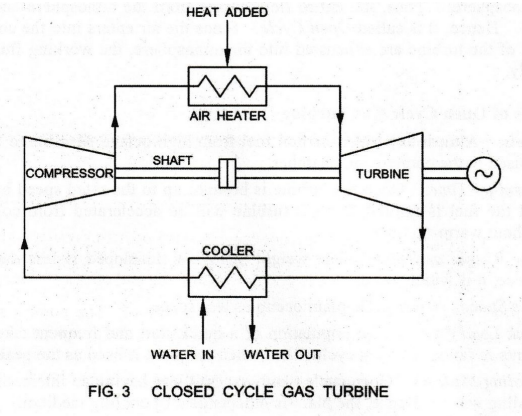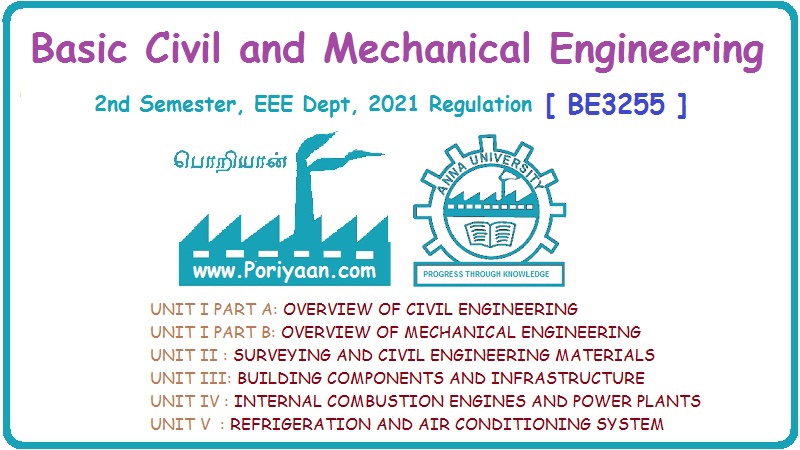Basic Civil & Mechanical Engineering: UNIT IV: e. Gas Turbines
Classification of Gas Turbines
and its Construction Layout Diagram, Working Principle, Advantages, Disadvantages
Gas turbines are classified as follows: 1. Open Cycle Gas Turbine and 2. Closed Cycle Gas Turbine
CLASSIFICATION OF GAS
TURBINES
Gas
turbines are classified as follows:
1.
Open Cycle Gas Turbine and
2.
Closed Cycle Gas Turbine
The
basic difference between the open cycle and closed cycle is the course of flow
of the working fluid in the cycle of operation. If the flow of the working
fluid comes from the atmosphere and is returned back to the atmosphere in each
cycle of operation, then the gas turbine is set to work on Open Cycle. Instead,
if the flow of the working fluid is confined within the cycle path and used
again and again, the gas turbine works on Closed Cycle.
1. OPEN CYCLE GAS TURBINE
Description
Fig. 1 shows an Open Cycle Gas Turbine. It
consists of a compressor, combustion chamber and gas turbine. The compressor,
turbine and the generator are coupled coaxially. The combustion chamber is
connected between the compressor and the turbine. The compressor is driven by
the turbine.

Working
Principle
Fig.
2 shows the block diagram of an Open Cycle Gas Turbine. Atmospheric air is
drawn in and passed through the air filter. It then flows into the compressor
and is compressed.

The
compressed air is heated by directly burning the fuel (natural gas or coal gas
or kerosene or gasoline) in the air at constant pressure in the combustion
chamber. Then, the high pressure hot gases expand in the turbine and mechanical
power is developed.
Note
that major percentage of power developed (66%) by the gas turbine is used to
run the compressor. Remaining power is available as useful output.
The
working fluid, i.e., air and fuel, must be replaced continuously as they are
exhausted into the atmosphere. Thus, the entire flow comes from the atmosphere
and is returned to the atmosphere. Hence, it is called Open Cycle. Since the
air enters into the compressor and gases coming out of the turbine are
exhausted into the atmosphere, the working fluid must be replaced continuously.
Advantages
of Open Cycle Gas Turbine
1. Fuels: Almost any hydro-carbon fuel from
high octane gasoline to heavy diesel oil can be used in the combustion chamber.
2. Warm-up Time: Once the turbine is brought
up to the rated speed by the starting motor and the fuel is ignited, the gas
turbine will be accelerated from cold start to full load without warm-up time.
3. Low Weight and Size: The weight in kg/kW
developed is less than the closed cycle. Hence, it is widely used.
4. Less Space: Open cycle plant occupies less
space.
5. Peak
Load Plant: The stipulation of a quick start and frequent take-up of load are
the points in favour of open cycle plant, when the plant is used as the peak
load plant.
6. Cooling
Medium: Open cycle plant, except those having an intercooler, does not require
cooling water. Hence, the plant is independent of cooling medium.
Disadvantages
of Open Cycle Gas Turbine
1. Less
Part Load Efficiency: Part load efficiency decreases rapidly, as considerable
percentage of power developed by the turbine is used to drive the compressor.
2. Sensitiveness:
Open cycle plant is sensitive to changes in the atmospheric air temperature,
pressure and humidity.
2. CLOSED CYCLE GAS TURBINE
Working
Principle
See
Fig. 3. In this, the fuel is not burnt directly in the air. The compressed air
from the compressor is heated in a heat exchanger (Air Heater) by an externally
fired combustion chamber using coal or oil. Thus, the working fluid is not
contaminated by the products of combustion and is constantly re-circulated.

Then,
the high pressure hot gases expand passing through the turbine and the pressure
is reduced. The thermal energy is converted into mechanical power.
The
exhaust gas is then cooled in a Cooler to its original temperature before
passing into the compressor again. The cooler is used to minimize the
compressor work.
The Main difference between the open and closed cycles is that the working fluid is continuously replaced in open cycle whereas it is used again and again in a closed cycle.
Advantages
of Closed Cycle Gas Turbine
1. No Erosion of Turbine Blades: The closed
cycle avoids erosion of the turbine blades due to the contaminated gases.
Therefore, its efficiency is not affected.
2. No Air Filtering: The need for filtration
of the incoming atmospheric air is a severe problem in the open cycle plant.
This problem is completely eliminated in closed cycle.
3. Inferior Oil or Solid Fuel: As indirect
heating is used in the closed cycle plant, an inferior oil or solid fuel can be
used in the combustion chamber. These fuels can be used more economically,
because these are available in abundance.
4. Low Maintenance Cost: The maintenance cost
of closed cycle plant is low.
Disadvantages
of Closed Cycle Gas Turbine
1. Requirement of Cooling Water: The system is
dependent of external means, as considerable quantity of cooling water is
required in the cooler.
2.
Response to Load Variations. The response to the load variations is poor
compared to the open cycle plant.
3.
Big Heat Exchangers: The closed cycle plant requires very big heat exchangers,
since the heating of the working fluid is done indirectly. The space required
for the heat exchanger is considerably large. The full heat of the fuel is also
not used in this plant.
Basic Civil & Mechanical Engineering: UNIT IV: e. Gas Turbines : Tag: : and its Construction Layout Diagram, Working Principle, Advantages, Disadvantages - Classification of Gas Turbines
Related Topics
Related Subjects
Basic Civil and Mechanical Engineering
BE3255 2nd Semester 2021 Regulation | 2nd Semester EEE Dept 2021 Regulation
